

Learn to Speak English Fluently. ESL Treasure. People watchingGo for a walk outside or look out of the window and analyses passers-by.
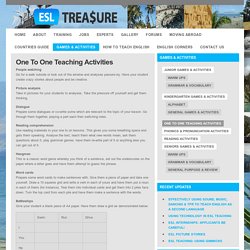
Have your student create crazy stories about people and be creative. Picture analysisTake in pictures for your students to analyses. Take the pressure off yourself and get them thinking. DialoguePrepare some dialogues or co-write some which are relevant to the topic of your lesson. Go through them together, playing a part each then switching roles. Reading comprehensionUse reading materials in your one to on lessons. HangmanThis is a classic word game whereby you think of a sentence, set out the underscores on the paper where a letter goes and have them attempt to guess the phrase.
Word cardsPrepare some word cards to make sentences with. BattleshipsGive your student a blank piece of A4 paper. Use the relevant vocabulary according to your grammar point. BrainstormPick a theme or grammar point and brainstorm examples and ideas together on the board. Home - Sitzman ABC. Teaching Children One to One: Tips to Make your Lessons Fun. On the ESL forums one often sees teachers asking for ideas on how to make their one to one lessons more fun.
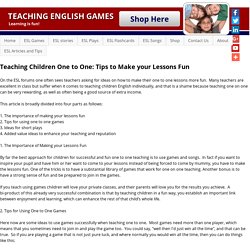
Many teachers are excellent in class but suffer when it comes to teaching children English individually, and that is a shame because teaching one on one can be very rewarding, as well as often being a good source of extra income. This article is broadly divided into four parts as follows: 1. The importance of making your lessons fun2. One-to-ones. One-to-One Lessons by Alan Marsh Some teachers love them, some hate them: one-to-one lessons, 121, Private Lessons, Individual Lessons – they go by different names, but they all come down to the same thing – you’re alone with a learner, and usually you’re their only teacher.

Sometimes they may also be taking part in a group course, and may have opted for an extension. Their reasons for doing so are various, but usually it’s because they want to focus on a specific area, or they want individual attention, or both. I’ve often been asked to write down some tips and advice for teachers who feel unsure about teaching one-to-one, and perhaps to run a workshop. I’ve been to several workshops myself, and although they often provide useful insights and some practical techniques, they have the problem that every learner is different, with different personalities, learning styles, strengths and weaknesses, practical needs and language learning experiences. . • What risks do I take? Interests them. The Teacher's Handbook for Great One-on-one ESL Lessons. You’re about to go mano-a-mano with an ESL student for the first time.

Wondering how to make a one-on-one lesson as awesome as possible? Well, we just happen to have a great formula for one-on-one ESL lesson success. Every classroom and every student is different, so there’s not one trick that will help you teach everyone. But we’ve started to notice a pattern. Many ESL teachers start off without being fully prepared for the variations that come with adapting to one-on-one lessons.
Figuring out the appropriate structure, content and overall teacher-student dynamic can be challenging when you’re used to classrooms or group lessons. Private Teaching. One To One Teaching Activities « ESL Treasure. One-to-one Methodology: Ten activities. By Nicola Meldrum and Lindsay Clandfield Ten activities for teaching one-to-one classes 1.
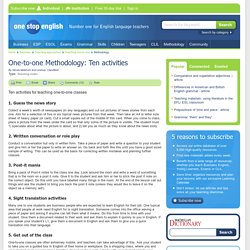
Guess the news story Collect a week’s worth of newspapers (in any language) and cut out pictures of news stories from each one. Aim for a selection of five or six topical news pictures from that week. How to Teach Your First English Conversation Class - Tips for ESL/EFL. Here is my approach to teaching English to a student or small group of students (e.g. 4 people) for the first time.
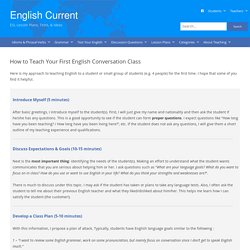
I hope that some of you find it helpful. Introduce Myself (5 minutes) After basic greetings, I introduce myself to the student(s). First, I will just give my name and nationality and then ask the student if he/she has any questions. This is a good opportunity to see if the student can form proper questions. Discuss Expectations & Goals (10-15 minutes) Next is the most important thing: identifying the needs of the student(s). There is much to discuss under this topic. Develop a Class Plan (5-10 minutes) With this information, I propose a plan of attack. 1 – “I want to review some English grammar, work on some pronunciation, but mainly focus on conversation since I don’t get to speak English much.” For pronunciation, I do my best to listen to the students and write down potential areas of improvement.
For conversation, it depends on the student’s interests. There it is. Teaching English to Small Classes. Most teachers would agree that teaching a small class rather than a large class comes with many benefits.
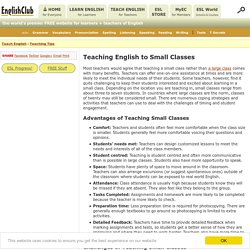
Teachers can offer one-on-one assistance at times and are more likely to meet the individual needs of their students. Some teachers, however, find it quite challenging to keep their students interested and excited about learning in a small class. Depending on the location you are teaching in, small classes range from about three to seven students. In countries where large classes are the norm, classes of twenty may still be considered small. There are numerous coping strategies and activities that teachers can use to deal with the challenges of timing and student engagement. Advantages of Teaching Small Classes Comfort: Teachers and students often feel more comfortable when the class size is smaller.
Challenges of Teaching Small Classes Strategies for Coping with Small Classes Fillers: Always have plenty of fillers (such as puzzles and games) ready in case activities finish quickly.